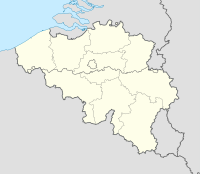
Back Schlacht von Gembloux German Gembloux’n taistelu Finnish Bataille de Gembloux (1940) French Pertempuran Gembloux (1940) ID Battaglia di Gembloux Italian Slag om Gembloers (1940) Dutch Batalha de Gembloux (1940) Occitan Bitwa pod Gembloux (1940) Polish Bătălia de la Gembloux (1940) Romanian Сражение при Жамблу Russian
| Battle of Gembloux | |||||||
|---|---|---|---|---|---|---|---|
| Part of the Battle of Belgium, Western Front of World War II | |||||||
 The Gembloux Gap. The Belgian central plain between Namur and Wavre was occupied by the French Corps de Cavalerie (Général René Prioux), to prevent a German breakthrough into France. | |||||||
| |||||||
| Belligerents | |||||||
|
|
| ||||||
| Commanders and leaders | |||||||
|
|
| ||||||
| Strength | |||||||
|
3 motorised divisions 3 infantry divisions |
2 panzer divisions 3 infantry divisions | ||||||
| Casualties and losses | |||||||
|
2,000 killed, wounded & missing III Corps: few hundred casualties[3] |
33–37 percent of German tank strength lost 4th Panzer on 15 May: 1,000+ killed, wounded, or missing IV Corps: few hundred casualties.[4] | ||||||
The Battle of Gembloux[5] (or Battle of the Gembloux Gap) was fought between French and German forces in May 1940 during the Second World War. On 10 May 1940, The Nazi Wehrmacht, invaded Luxembourg, The Netherlands and Belgium under the operational plan Fall Gelb (Case Yellow). Allied armies responded with the Dyle Plan (Breda variant), intended to halt the Germans in Belgium, believing it to be the main German thrust. The Allies committed their best and most mobile to an advance into Belgium on 10 May and on 12 May, the Germans began the second part of Fall Gelb, the Manstein Plan an advance through the Ardennes, to reach the English Channel and cut off the Allied forces in Belgium.
Unaware that the German invasion of the Low Countries was a decoy, the French Army intended to halt the German advance into central Belgium and France on two defensive positions at the towns of Hannut and Gembloux. The French First Army, the most powerful Allied army, was to defend the Gembloux–Wavre axis. The French Corps de Cavalerie (Général René Prioux), advanced to Hannut, to screen the deployment of the rest of the First Army at Gembloux, by delaying a German advance.
After the Battle of Hannut, some 35 km (22 mi) to the north-east, the French retired towards Gembloux and the principal defensive position for the French on the Belgian front. For two days French defeated attacks by elements of the 6th Army. The German surprise attack through the Ardennes and the crossing of the Meuse at Sedan, forced the First Army to retreat from Gembloux, then back over the French frontier towards Lille. The retreat disorganised the Allied defence on the central sector of the Belgian front and the German armies occupied central Belgium. Strategically the battle was inconclusive, it diverted the First Army from Sedan, which allowed the Germans to achieve the strategic goals of Fall Gelb but the First Army survived and during the Siege of Lille diverted German forces from the Battle of Dunkirk, which allowed the British Expeditionary Force and a substantial French contingent to escape.
- ^ Gunsburg 2000, p. 140.
- ^ Frieser 2005, pp. 243–244.
- ^ Gunsburg 2000, pp. 137–138.
- ^ Gunsburg 2000, p. 137.
- ^ Gunsburg 2000, p. 97.
Cite error: There are <ref group=nb> tags on this page, but the references will not show without a {{reflist|group=nb}} template (see the help page).
